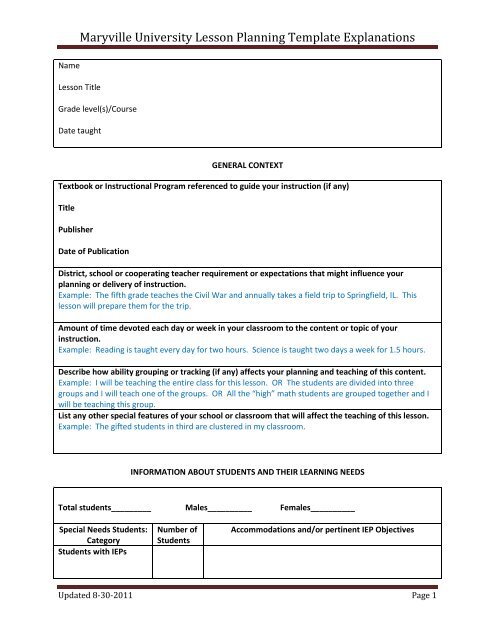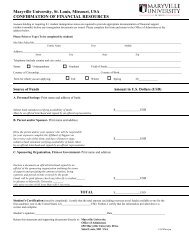Maryville University Lesson Planning Template Explanations
Maryville University Lesson Planning Template Explanations
Maryville University Lesson Planning Template Explanations
Create successful ePaper yourself
Turn your PDF publications into a flip-book with our unique Google optimized e-Paper software.
<strong>Maryville</strong> <strong>University</strong> <strong>Lesson</strong> <strong>Planning</strong> <strong>Template</strong> <strong>Explanations</strong><br />
Name<br />
<strong>Lesson</strong> Title<br />
Grade level(s)/Course<br />
Date taught<br />
GENERAL CONTEXT<br />
Textbook or Instructional Program referenced to guide your instruction (if any)<br />
Title<br />
Publisher<br />
Date of Publication<br />
District, school or cooperating teacher requirement or expectations that might influence your<br />
planning or delivery of instruction.<br />
Example: The fifth grade teaches the Civil War and annually takes a field trip to Springfield, IL. This<br />
lesson will prepare them for the trip.<br />
Amount of time devoted each day or week in your classroom to the content or topic of your<br />
instruction.<br />
Example: Reading is taught every day for two hours. Science is taught two days a week for 1.5 hours.<br />
Describe how ability grouping or tracking (if any) affects your planning and teaching of this content.<br />
Example: I will be teaching the entire class for this lesson. OR The students are divided into three<br />
groups and I will teach one of the groups. OR All the “high” math students are grouped together and I<br />
will be teaching this group.<br />
List any other special features of your school or classroom that will affect the teaching of this lesson.<br />
Example: The gifted students in third are clustered in my classroom.<br />
INFORMATION ABOUT STUDENTS AND THEIR LEARNING NEEDS<br />
Total students_________ Males__________ Females__________<br />
Special Needs Students:<br />
Category<br />
Students with IEPs<br />
Number of<br />
Students<br />
Accommodations and/or pertinent IEP Objectives<br />
Updated 8-30-2011 Page 1
<strong>Maryville</strong> <strong>University</strong> <strong>Lesson</strong> <strong>Planning</strong> <strong>Template</strong> <strong>Explanations</strong><br />
English Language<br />
Learners<br />
Gifted<br />
504<br />
Autism or other special<br />
needs<br />
INFORMATION ABOUT THE LESSON<br />
Content Strand<br />
This information is found on the DESE GLE website at the top of each page. Example: Writing,<br />
Speaking, Reading are some of the strands for Communication Arts.<br />
Enduring Understanding and/or Essential Question<br />
The important, powerful ideas that enable us to make sense of isolated facts. What is the big idea of<br />
that your lesson encompasses?<br />
GLE(s) or EOC and Symbolic Notation<br />
Grade Level Expectation/End of Course<br />
Found on the DESE website under the content<br />
strand. They specifically explain what learning is<br />
expected,<br />
Symbolic Notation for the GLE<br />
Found on the DESE website under the GLE<br />
Example (MA 3.1) (SS7 1.2)<br />
DOK<br />
Depth of Knowledge<br />
A number between 1 and 4 representing the level<br />
of the GLE. The numbers are found on the DESE<br />
website under the GLE. Not all content areas have<br />
a DOK. If DOK not given, you need to realistically<br />
estimate the DOK given the demands of your<br />
lesson<br />
Outcome(s)<br />
A statement indicating what the student will know, understand or be able to do at the end of the lesson.<br />
Verbs are typically from Bloom’s Taxonomy. Usually the outcome begins with “The student will be able<br />
to….” Consider both knowledge and skill outcomes to include.<br />
Academic Language related to the lesson<br />
The language of education that is different from everyday spoken language. The content specific terms<br />
(ex: compose, decompose, integer, phonemic awareness) and the process terms (ex: theory,<br />
hypothesis, evaluate) that enable a student to be successful in the classroom.<br />
Prior Learning/Prior Thinking<br />
How have learners encountered this content before, either through experience in daily life or prior<br />
instruction? What related content have the students learned that has laid a foundation for this lesson?<br />
What errors in understanding or thinking (i.e, misconceptions) might learners bring to the classroom?<br />
Updated 8-30-2011 Page 2
<strong>Maryville</strong> <strong>University</strong> <strong>Lesson</strong> <strong>Planning</strong> <strong>Template</strong> <strong>Explanations</strong><br />
LESSON IMPLEMENTATION<br />
Anticipatory Set/Elicit Prior Knowledge<br />
How will you get students to activate their prior associations, ideas, or connections to your lesson?<br />
The “hook” that gets the students excited and anxious to participate in the lesson. A short statement,<br />
question, or example that relates to the topic and to the interests/prior knowledge of the students.<br />
Leads into the focus statement.<br />
Example MATH: If you are teaching a lesson on 3-dimensional geometric figures, you might say…”Did<br />
you see a 3-D movie this summer? How was it different from most movies you watch?” Then, you can<br />
say, “Today we are going to look at shapes that are 3-dimensional.” Example LITERATURE: “We’ve<br />
been studying poetry, and today we’re going to learn about a very special kind of poetry called Haiku.<br />
Listen to this and tell me what you notice about haiku and how it is similar and different from the poetry<br />
we’ve studied up to now.” I will read “Haiku for cats”, by ….. “What did you notice?”<br />
Focus/Purpose Statement<br />
A short, simple statement by the teacher using student-friendly language that tells the students what<br />
they will be doing during the lesson and why it is important. Tell them the big idea or goal. Example<br />
MATH: Our world is three dimensional, so understanding 3 dimensional shapes helps us better<br />
represent the world as we experience it. [EQ: How can we use math to represent the world?]<br />
Example LITERATURE: “Today we will learn about haiku as another form of poetry. As we learn today,<br />
keep in mind our big question: How do authors use word choice and structure to create mood?” You will<br />
be able to create your Haiku at the end of the lesson. We will also share some of our creations.”<br />
Procedures<br />
This is the heart of the lesson plan. In this section explain the logical, sequential steps you will follow as<br />
you teach. Explain what you will say and do to ensure student thinking and ultimately learning. What<br />
strategies, activities, and examples will you incorporate into your lesson? How will you transition<br />
children from one segment of the lesson to another segment? What questions will you ask during each<br />
portion of the lesson. What technology or materials will you be using and how will you use them? Look<br />
at the LESSON PLANNING CHECKLIST on pages 4-5 as well as any special requirements for particular<br />
content disciplines.<br />
Differentiation<br />
How specifically will you differentiate for different levels of ability and/or different levels of content<br />
knowledge? How will you use different strategies for learning and/or cultural and language<br />
differences? What are those different strategies?<br />
Closure<br />
At the conclusion of the lesson, closure is the time to help the students organize the information that<br />
has been presented to aid their retention. The students should do the thinking and discussion rather<br />
than the teacher. The teacher can engage them in a short review by posing questions. The students<br />
should be given a chance to personally reflect on the lesson, to share their ideas with others and with<br />
the class as a whole.<br />
Materials and Resources<br />
What items will you need to successfully complete the lesson? What materials, manipulatives, books,<br />
office supplies and other items will be needed for the lesson?<br />
Classroom Management/Democratic Practices<br />
What management systems are in place that you must follow? What do you anticipate may happen<br />
either by the class as a whole or by individuals, and what plans do you have for preventing and<br />
responding to these possible occurrences? How will you promote a democratic classroom community?<br />
Updated 8-30-2011 Page 3
<strong>Maryville</strong> <strong>University</strong> <strong>Lesson</strong> <strong>Planning</strong> <strong>Template</strong> <strong>Explanations</strong><br />
Example: If you know a student has a tendency to blurt out an answer before being called upon, what<br />
will you say and/or do if this happens? Respecting others’ rights to think and speak is a democratic skill.<br />
Before the lesson<br />
ASSESSMENT<br />
Gathering information about student knowledge<br />
How will you identify students’ academic development and social/emotional development, including<br />
strengths, experiences and interests, to help students reach the learning objectives?<br />
Pre-assessment that may be used<br />
During the lesson<br />
How will you know if your students understand the lesson while you are teaching? How will you provide<br />
feedback during the lesson that helps the student understand what s/he did well and helps the student<br />
improve his/her work or understanding? How will you judge differing depths of student understanding?<br />
Informal Formative Assessment<br />
This may include Guided Practice, Independent Practice, Questioning, structured Observations, etc.,<br />
including what you will be looking for.<br />
Formal Formative Assessment<br />
At the end of the lesson<br />
How will you know if your students understood the lesson? How will assessments provide evidence of<br />
student learning relative to the objectives for the lesson? How will you differentiate assessments for<br />
students having difficulty demonstrating their learning as well as those needing more challenge? How<br />
are the assessments aligned to clearly defined benchmarks or criteria for student performance?<br />
Formative<br />
Summative<br />
LESSON PLANNING CHECKLIST<br />
Does the plan logically lay out what you will say and do?<br />
Did you include specific questions you will ask to invite, guide, and develop students’<br />
thinking throughout the lesson?<br />
What strategies will you use?<br />
Have you included how you will set expectations for student behavior before and during<br />
the lesson (picking up materials; collaborative work time; listening behaviors, moving<br />
from one place to the next, etc.)?<br />
Updated 8-30-2011 Page 4
<strong>Maryville</strong> <strong>University</strong> <strong>Lesson</strong> <strong>Planning</strong> <strong>Template</strong> <strong>Explanations</strong><br />
If students work in groups, have you included how you will group them and why that<br />
approach is appropriate to their learning needs?<br />
Have you specified how you will ensure students understand the academic language<br />
needed to succeed during this lesson?<br />
What content-specific vocabulary will you introduce and how will you introduce it?<br />
Do you plan for guided work so that students must use the ideas/skills they learn?<br />
Do you plan for students to independently work with or apply the ideas/skills?<br />
Do you include how you will differentiate for the varying needs of diverse students<br />
(gifted/remedial; ELL; social/emotional)?<br />
How will you collect evidence of students’ thinking and learning (formative assessments)<br />
during the lesson?<br />
REFLECTION<br />
If you have not had a conference at the completion of your lesson, or if your instructor asks for<br />
this, send a REFLECTION to your practicum supervisor.<br />
In your reflection address each of the following.<br />
1. Focus on student thinking and learning.<br />
2. What was working? What was not working? For whom? Why?<br />
3. Use specific examples of students’ work, actions or quotes to support your claims.<br />
4. What missed opportunities for student learning are you aware of that happened?<br />
5. If you could do it over, what might you have done to take advantage of missed<br />
opportunities to improve the learning of students with diverse needs?<br />
6. In your own classroom what would you teach next to build on this lesson?<br />
Link your ideas to your methods class content and readings, using appropriate and accurate<br />
quotes from text or theorists as you analyze and evaluate your work. Cite your quotes in APA<br />
style.<br />
Updated 8-30-2011 Page 5
















